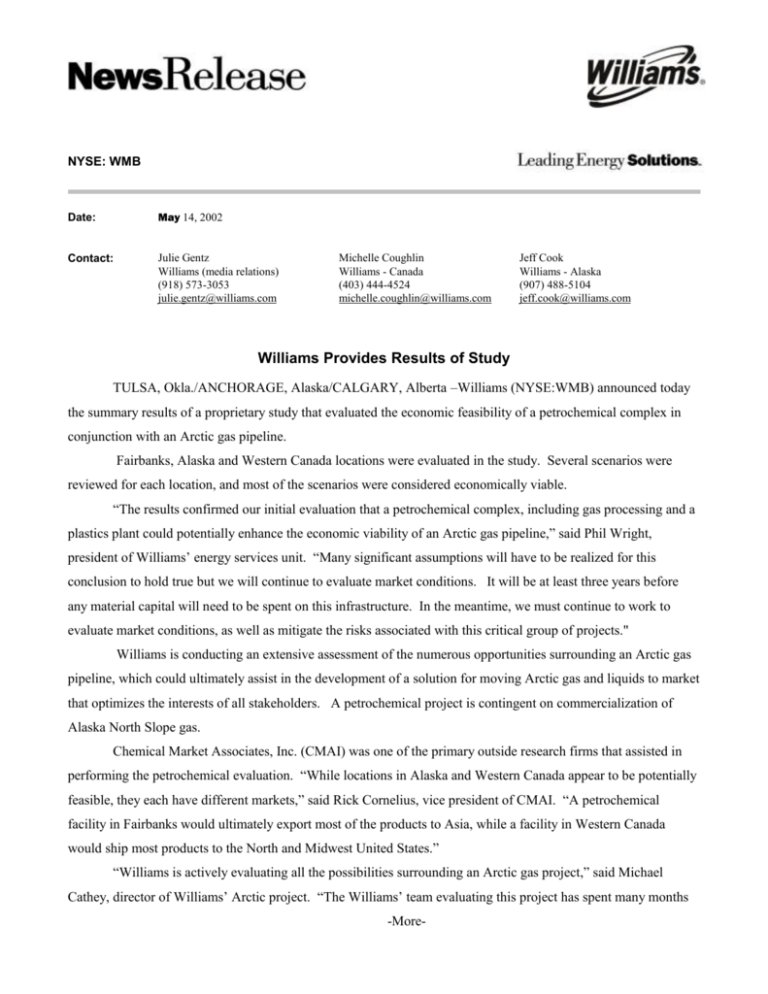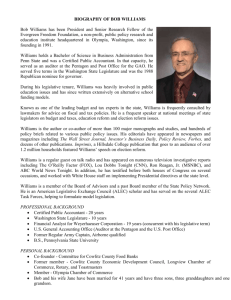Williams Provides Results of Study
advertisement

NYSE: WMB Date: May 14, 2002 Contact: Julie Gentz Williams (media relations) (918) 573-3053 julie.gentz@williams.com Michelle Coughlin Williams - Canada (403) 444-4524 michelle.coughlin@williams.com Jeff Cook Williams - Alaska (907) 488-5104 jeff.cook@williams.com Williams Provides Results of Study TULSA, Okla./ANCHORAGE, Alaska/CALGARY, Alberta –Williams (NYSE:WMB) announced today the summary results of a proprietary study that evaluated the economic feasibility of a petrochemical complex in conjunction with an Arctic gas pipeline. Fairbanks, Alaska and Western Canada locations were evaluated in the study. Several scenarios were reviewed for each location, and most of the scenarios were considered economically viable. “The results confirmed our initial evaluation that a petrochemical complex, including gas processing and a plastics plant could potentially enhance the economic viability of an Arctic gas pipeline,” said Phil Wright, president of Williams’ energy services unit. “Many significant assumptions will have to be realized for this conclusion to hold true but we will continue to evaluate market conditions. It will be at least three years before any material capital will need to be spent on this infrastructure. In the meantime, we must continue to work to evaluate market conditions, as well as mitigate the risks associated with this critical group of projects." Williams is conducting an extensive assessment of the numerous opportunities surrounding an Arctic gas pipeline, which could ultimately assist in the development of a solution for moving Arctic gas and liquids to market that optimizes the interests of all stakeholders. A petrochemical project is contingent on commercialization of Alaska North Slope gas. Chemical Market Associates, Inc. (CMAI) was one of the primary outside research firms that assisted in performing the petrochemical evaluation. “While locations in Alaska and Western Canada appear to be potentially feasible, they each have different markets,” said Rick Cornelius, vice president of CMAI. “A petrochemical facility in Fairbanks would ultimately export most of the products to Asia, while a facility in Western Canada would ship most products to the North and Midwest United States.” “Williams is actively evaluating all the possibilities surrounding an Arctic gas project,” said Michael Cathey, director of Williams’ Arctic project. “The Williams’ team evaluating this project has spent many months -More- Page 2 of 2/ Williams Provides Results of Petrochemical Study analyzing the various factors that would make the pipeline and related projects successful. We look forward to working with our industry peers, the State of Alaska, the Canadian provincial governments and various other U.S. and Canadian government agencies to continue assessing and mitigating key risk elements toward building this essential link connecting North Slope gas to North American markets.” Among the benefits to the community selected for a petrochemical complex would be a peak construction workforce of 4,000, with a permanent work force of up to 400 people. Williams’ Arctic project team will continue to work with potential business partners, local communities, governmental entities, suppliers and contractors. Williams owns extensive energy operations in both Alaska and Canada. In Alaska, Williams owns and operates a 200,000 barrel-per-day refinery, petroleum terminals, convenience stores and owns a minority interest in the Trans Alaska Pipeline. In Canada, Williams owns a 14.6 percent interest in the Alliance pipeline system, which delivers 1.5 billion cubic feet per day of wet gas from Western Canada to the Chicago area. Williams also owns extensive gas processing and natural gas liquid production, fractionation and storage capacity in Alberta and British Columbia. About Williams (NYSE: WMB) Williams moves, manages and markets a variety of energy products, including natural gas, liquid hydrocarbons, petroleum and electricity. The company’s operations span the energy value chain from wellhead to burner tip. Based in Tulsa, Okla., Williams and its 12,000 worldwide employees contributed $45 million in 2001 to support the environment, health and human services, the arts, and education in its communities. Williams information is available at www.williams.com. ### Portions of this document may constitute “forward-looking statements” as defined by federal law. Although the company believes any such statements are based on reasonable assumptions, there is no assurance that actual outcomes will not be materially different. Any such statements are made in reliance on the “safe harbor” protections provided under the Private Securities Reform Act of 1995. Additional information about issues that could lead to material changes in performance is contained in the company’s annual reports filed with the Securities and Exchange Commission.







